Developer Guide
Table of Contents
- Acknowledgements
- Setting Up
- Design
- Implementation
- Other Relevant Documentation
- Appendix A: Requirements
- Appendix B: Instructions for Manual Testing
- B.1. Launch and Shutdown
- B.2. View Sample Job Application List
- B.3. View Job Application List
- B.4. Add Job Application
- B.5. Delete Job Application
- B.6. Edit Job Application
- B.7. Add Interview to Job Application
- B.8. Delete Interview from Job Application
- B.9. Edit Interview from Job Application
- B.10. Sort Job Application List
- B.11. Find Job Application
- B.12. Clear Job Application List
- B.13. Exit JobFindr
- B.14. Help
- Appendix C: Effort
- Appendix D: Planned Enhancements
Acknowledgements
All code and documentation are either written by ourselves or adopted from the original AB3 implementation.
Setting Up
Refer to the guide “Setting up and getting started”.
Design
.puml files used to create diagrams in this document can be found in the diagrams folder. Refer to the PlantUML Tutorial to learn how to create and edit diagrams.
Architecture
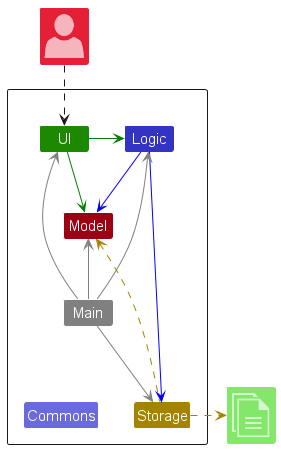
The architecture diagram above explains the high-level design of the App.
A quick overview of the main components and how they interact with each other is as follows:
Main Components
Main has two classes: Main and MainApp which are the entry and exit points of the application.
- At launch: They initialize the components in the correct sequence and connect them together.
- At exit: They ensure the components are shut down properly and invoke cleanup operations if necessary.
Commons represents the common classes used by all components.
The other four components of the App are as follows:
UI: Handles the user interface of the application.Logic: Handles command execution and data manipulation.Model: Stores the data of the application.Storage: Handles the saving and loading of data on the hard disk.
Component Interactions
The sequence diagram below shows the interactions between components for the delete 1 command:
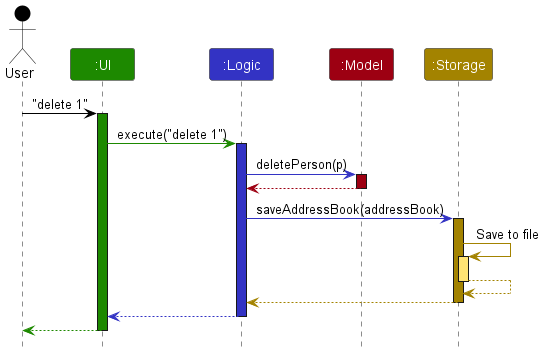
Each of the four main components:
- Defines its API in an
interfacenamed after the component. - Implements its functionality using a
{Component Name}Managerclass, following the corresponding API interface.
For example, the Logic component’s API is defined in Logic.java, and its functionality is implemented in LogicManager.java.
Other components interact with a given component (e.g. Logic) by calling methods defined in the corresponding API interface (e.g. Logic.java) instead of calling methods directly on the implementation class (e.g. LogicManager.java). This is to ensure that the caller does not depend on the implementation details of the component. This is illustrated in the class diagram below:
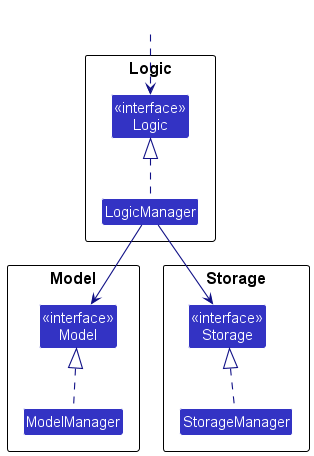
UI Component
API:
Ui.java
The UI component is responsible for managing the user interface of the application so that it can respond according to
the user’s actions or commands entered.
The UI component uses the JavaFx UI framework. The layout of these UI parts are defined in matching .fxml files that
are in the src/main/resources/view folder. For example, the layout of
the MainWindow
is specified
in MainWindow.fxml.
The UI component,
- Executes user commands using the
Logiccomponent. - Listens for changes to
Modeldata so that the UI can be updated with the modified data. - Keeps a reference to the
Logiccomponent, because the UI relies on the Logic to execute commands. - Depends on some classes in the
Modelcomponent, as it displaysJobobjects residing in the Model.
The following is a class diagram of the UI component:
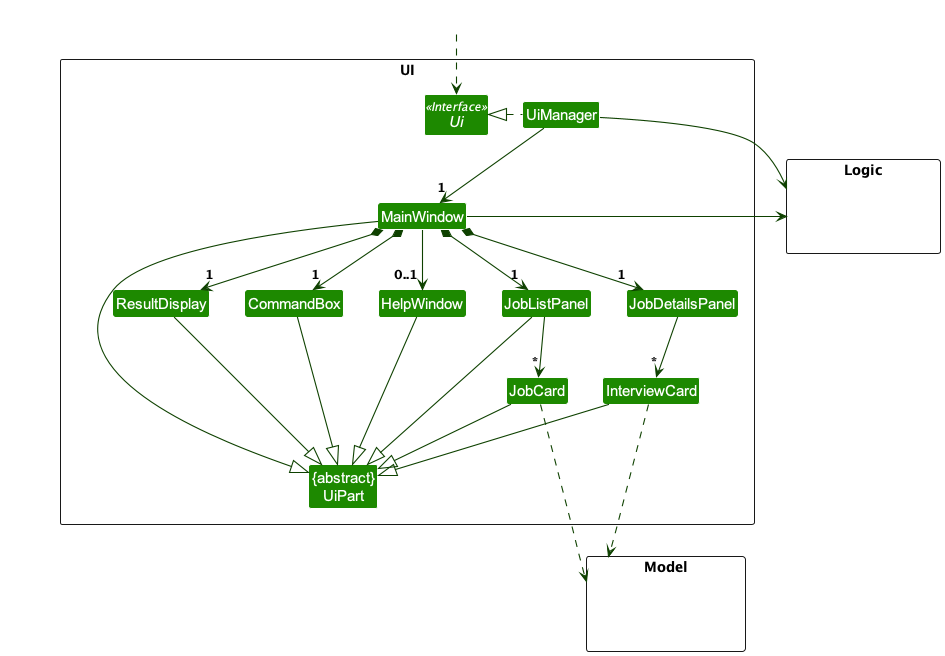
The UI consists of a MainWindow that is made up of parts like CommandBox and ResultDisplay. These parts are always
being shown in MainWindow, while other parts like JobListPanel, JobDetailsPanel are only visible to the user
depending on the state of the application (e.g. when the job list is not empty, or when a job is selected). All these,
including the MainWindow, inherit from the abstract UiPart class which captures the commonalities between classes
that represent parts of the visible GUI.
Logic Component
API:
Logic.java
The Logic component is responsible for handling the execution of commands so that the application book can be updated
according to the user’s instructions.
The following is a partial class diagram of the Logic component:
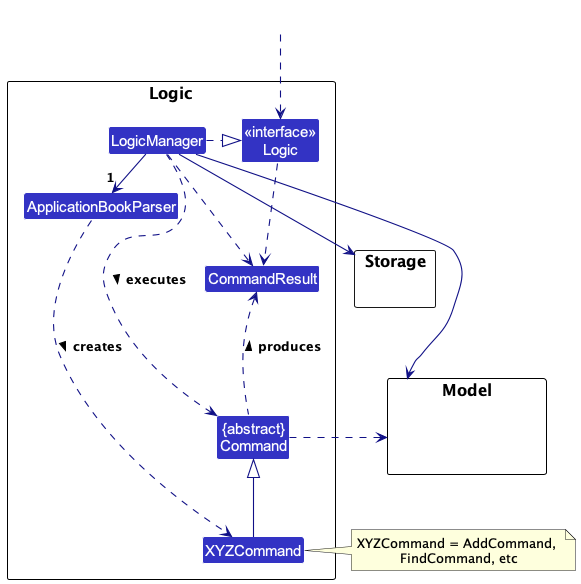
The following depicts the sequence of interactions within the Logic component taking the execute("delete 1") API
call as an example:
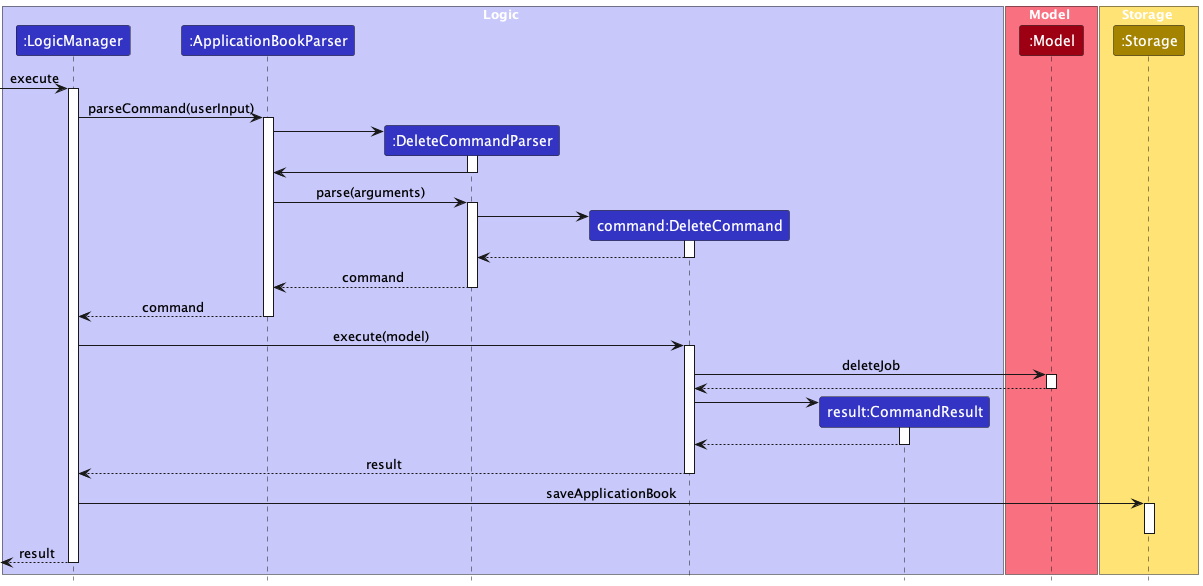
The Logic component,
- Reads the user input with the
ApplicationBookParserclass and creates a parser which matches the command (e.g.DeleteCommandParser) and uses it to parse the command. - This results in a
Commandobject (more precisely, an object of one of its subclasses e.g.DeleteCommand) which is executed by theLogicManager. - The command can communicate with the
Modelwhen it is executed (e.g. to delete a person). - After making changes to the
Model, theStorageis updated to reflect these changes. - The result of the command execution is encapsulated as a
CommandResultobject which is returned back fromLogic.
The following are other classes in Logic (omitted from the class diagram above) that are used for parsing a user
command:
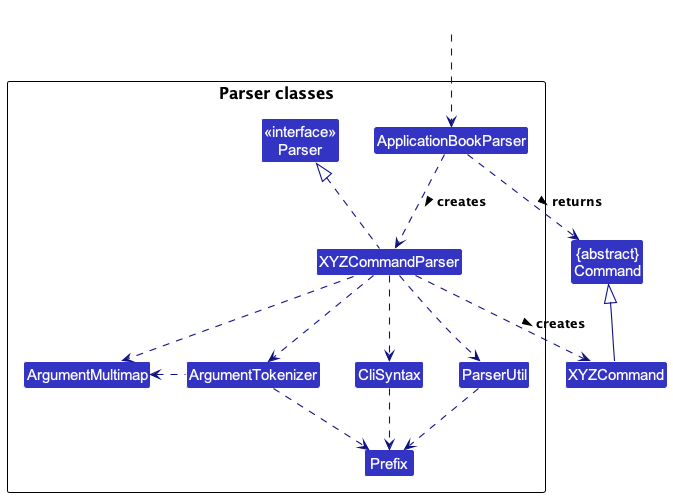
For more details about command-specific parsing and execution, refer to “Implementation”.
Model Component
API:
Model.java
The Model component is reponsible for encapsulating data and providing methods to modify the data.
The Model component,
- Stores the application book data i.e., all
Jobobjects (which are contained in aUniqueJobListobject). - stores the currently ‘selected’
Jobobjects (e.g., results of aFindCommand) as a separate filtered list which is exposed to outsiders as an unmodifiableObservableList<Job>that can be ‘observed’ (e.g. the UI can be bound to this list so that the UI automatically updates when the data in the list change. - Stores a
UserPrefobject that represents the user’s preferences. This is exposed to the outside as aReadOnlyUserPrefobject. - Does not depend on any of the other three components (as the
Modelrepresents data entities of the domain, they should make sense on their own without depending on other components).
The following is a class diagram of the Model component:
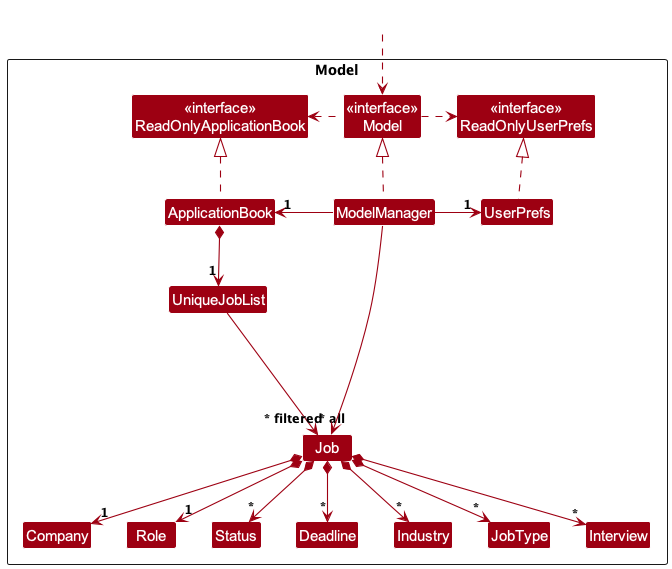
Storage Component
API:
Storage.java
The Storage component is responsible for storing the job application data in JSON format.
The Storage component,
- Saves both address book data and user preference data in JSON format, and read them back into corresponding objects.
- Inherits from both
AddressBookStorageandUserPrefStorage, which means it can be treated as either one (if only the functionality of only one is needed). - Depends on some classes in the
Modelcomponent (because theStoragecomponent’s job is to save/retrieve objects that belong to theModel).
The following is a class diagram of the Storage component:
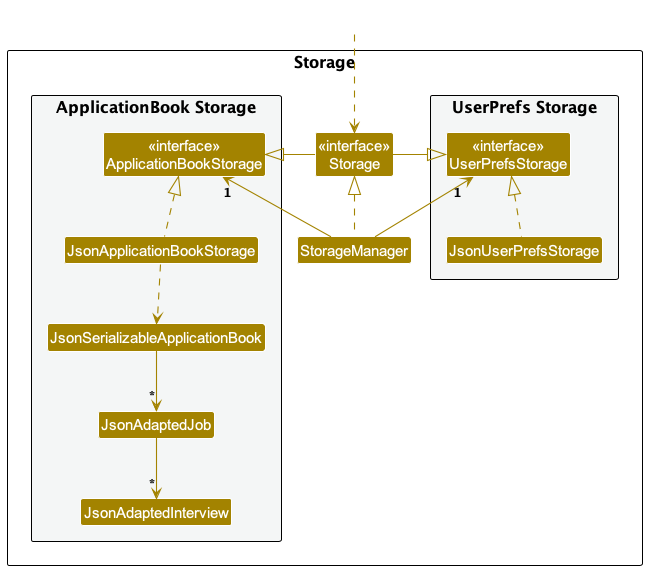
Common Classes
Classes used by multiple components are in the seedu.applicationbook.commons package.
Implementation
This section describes some noteworthy details on how certain features are implemented.
Add Command
The add command allows the user to add job applications with various attributes. Attributes can be categorized into
- Compulsory attributes such as
CompanyandRole. - Optional attributes such as
Status,Industry,DeadlineandJobType
Implementation
The following sequence diagrams illustrate the process of parsing and execution for the add command:
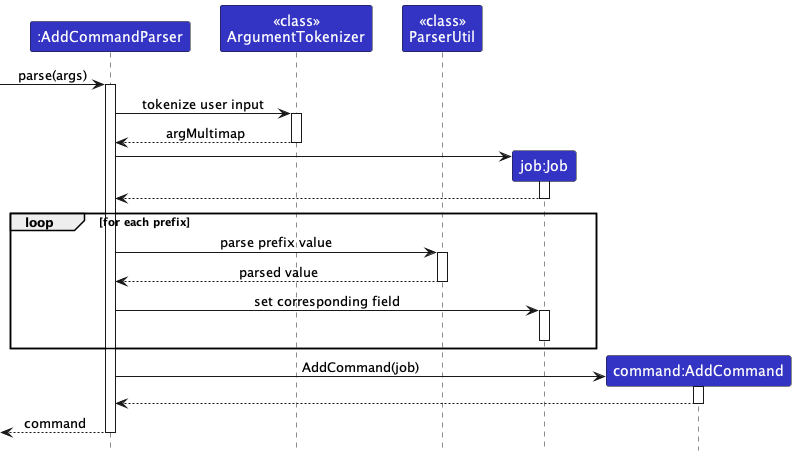
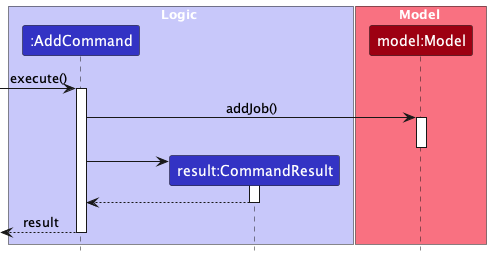
AddCommandParser takes in a user input, checking for necessary parameters and their validity. A Job object is
instantiated during AddCommandParser::parse and returned to the AddCommand. AddCommand::execute adds the new job
application to the UniqueJobList in the ApplicationBook.
Design Considerations
- Handling of optional parameters:
- Chosen implementation: The
AddCommandParserchecks for the presence of optional parameters. If the parameters are not present, default parameters are used to instantiate theJobobject. This is a simple implementation which does not require any changes to theAddCommandclass, but is not flexible as the default parameters are fixed. If the user wants to add a job application with a different set of default parameters, the code has to be changed. - Alternative: If the parameters are not present, a different constructor is used to instantiate the
Jobobject. This increases flexibility as the user can specify the parameters they want to add, but the implementation is more complicated as theAddCommandclass has to be modified to handle the different constructors.
- Chosen implementation: The
Edit Command
The edit command allows the user to edit any field in their job application.
Implementation
The Edit feature is implemented through the EditCommand class along with EditCommandParser to parse the arguments
for the command from the user input. It utilises a nested static class, EditJobDescriptor, to store the new values for
the job’s attributes.
The following sequence diagrams illustrate the process of parsing and execution for the edit command:
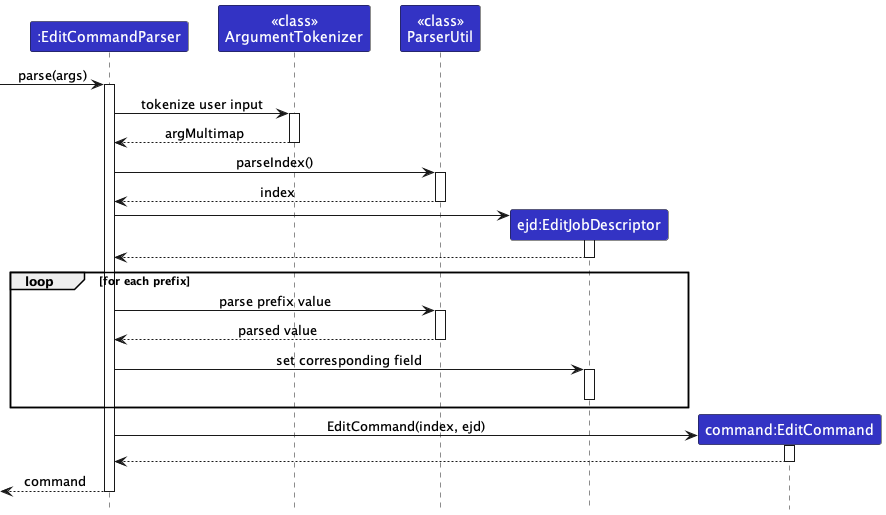
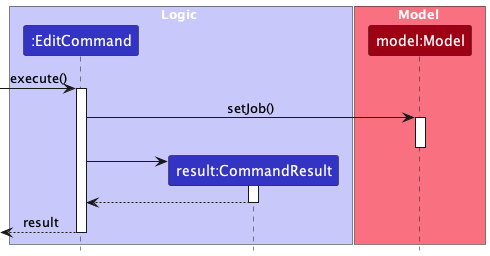
The EditCommandParser class parses the user input and creates an EditCommand object with the specified index and an
EditJobDescriptor containing the new field values.
The execute method in EditCommand is then called, which retrieves the current list of jobs and creates a new Job
object editedJob with updated field value that is contained by EditJobDescriptor. Replaces the old job with the new
one in the job list with Model::setJob.
Design considerations
- How to edit multiple fields with one command
- Chosen implementation: To enable the
editcommand to parse and edit multiple fields simultaneously, nested a static class,EditJobDescriptor, within theEditCommanditself. This design abstracts the logic of setting new values for each field away from theParserUtilandEditCommandParserclasses. It allows a single instance ofEditJobDescriptorto be carried through the execution sequence, instead of creating a separate instance for each field edited (e.g. a new Deadline instance if the deadline is edited). - Alternative: Editing each attribute with separate commands could simplify the command structure and reduce user errors. However, this might lead to increased added complexity in managing multiple instances of edited fields as described above.
- Chosen implementation: To enable the
Delete Command
The delete command allows the user to delete a job application using its index.
Implementation
The Delete command is implemented through the DeleteCommand class along with DeleteCommandParser to parse the
arguments for the command from the user input.
The following sequence diagrams illustrate the process of executing a valid delete command:
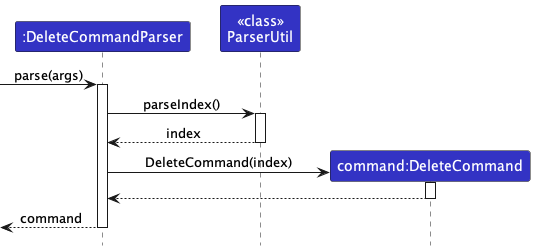
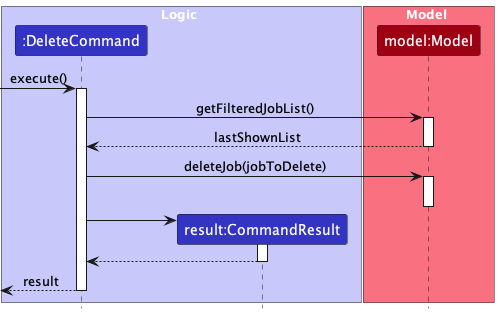
The DeleteCommandParser class parses the user input and creates a DeleteCommand object with the specified index.
If the user input does not conform to the expected format (e.g. the index is out of bounds), a ParseException is
thrown.
DeleteCommand::execute is then called, which retrieves the current list of jobs and deletes the job at the specified
index in the job list with Model::deleteJob.
Design considerations
- How to delete fields
- Chosen implementation: Only supports deleting the entire Job Application including all its fields.
- Alternative: To enable the
deletecommand to parse and delete specific optional fields of the application at the specified index, allow users to input specifiers (e.g.delete 1 s/) and modifyDeleteCommandParserto parse the specifiers, removing the ones corresponding to the specifiers.- Pros: More flexibility in changing the fields of an application.
- Cons: Good to have but not a necessary feature as users can simply
editthe fields and set them to the default (eg. TO_ADD_STATUS).
List Command
The list command allows the user to view the list of all job applications.
Implementation
The following sequence diagram illustrates the process of execution for the command:
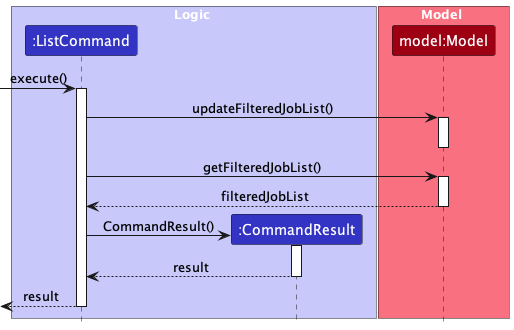
The ListCommand class implements this command. It sets the predicate for the filteredList of Model to
PREDICATE_SHOW_ALL_JOBS which evaluates any Job to true.
Design Considerations
- Implementing listing by
sortorder- Lists all applications by the date added if no
sortcommand was performed, otherwise lists by the most recentsortorder.- Pros: User is able to maintain the list in the preferred sorted order even after performing other commands such
as
deleteandfind. - Cons: The sorting order by date added is lost once
sortby other fields is performed.
- Pros: User is able to maintain the list in the preferred sorted order even after performing other commands such
as
- Lists all applications by the date added if no
Sort Command
The sort command allows the user to sort the current list of job applications based on a specified field.
Implementation
The SortCommand class implements this command. It accepts a FieldComparator which will be set as the comparator when
Model::sortJobs is called.
The following sequence diagrams illustrate the process of parsing and execution for the command:
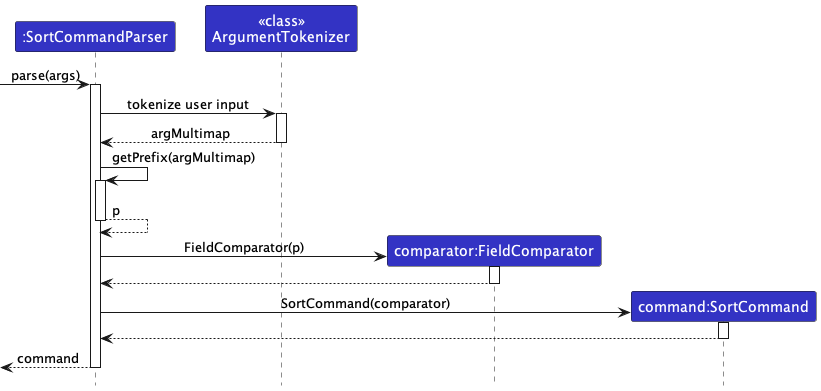
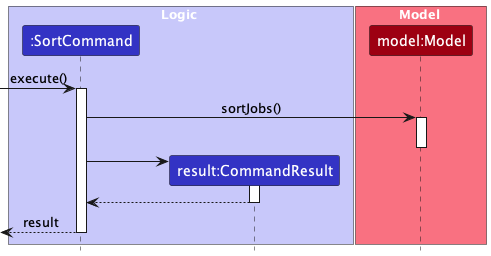
The SortCommandParser class uses the ArgumentTokenizer class to parse the arguments for the command from the user
input. If the user input does not conform to the expected format, a ParseException is thrown. If the user input is
valid, then SortCommandParser generates the corresponding FieldComparator which will be set as the comparator when
sorting the list.
The FieldComparator::compare method compares the field indicated by the specifier. To achieve this, the
relevant field method must be invoked.
- For alphabetically sorted fields (
Company,Role,Status,Industry,JobType),String::compareToIgnoreCaseis used. - For chronologically sorted fields (
Deadline), a customcompareTo()method is implemented.
Design considerations
- Implementing sorting in reverse order: Create a command which, when called, would reverse the order of the list
sorted.
- Pros: It is relatively simple to implement, as the
Comparator::reversedmethod allows the ordering of the list to be reversed easily. - Cons: This is not an important feature which users will need frequently, and it requires additional time to be
spent on implementing the command and creating test cases. In light of the tight schedule and other more important
features, we decided that this feature was not a priority.
- Pros: It is relatively simple to implement, as the
- Implementing sorting by multiple fields: When multiple prefixes are provided, sort by the prefix listed first,
and if two applications have the same value in that field, sort by the next prefix listed.
- Pros: This is slightly more complicated to implement, requiring a
Comparatorwhich can sort fields according to the desired order of importance. - Cons: Once again, we decided that this is not an important feature, as the primary purpose of the command is to allow users to group similar applications together. Grouping by one field should be sufficient for the user to have an organised list.
- Pros: This is slightly more complicated to implement, requiring a
Find Command
The find command allows the user to get a filtered list of job applications.
Implementation
The following sequence diagrams illustrate the process of parsing and invocation for the command:
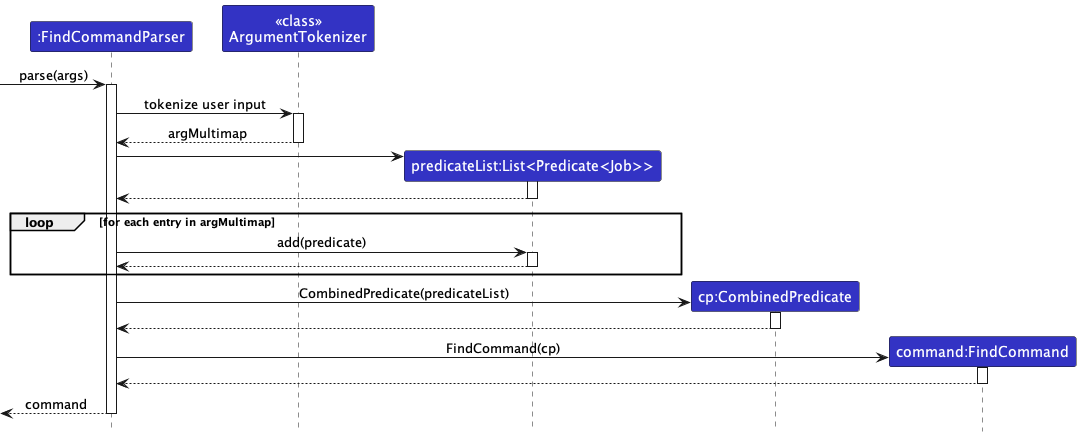
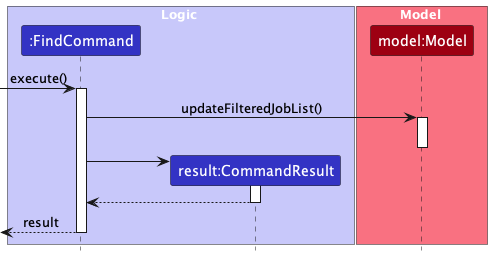
The FindCommand class implements this command. Its constructor accepts a CombinedPredicate which will be set as the
predicate when Model::updateFilteredJobList is called.
The FindCommandParser class uses the ArgumentTokenizer class to parse the arguments for the command from the user
input. If the user input does not conform to the expected format, a ParseException is thrown. If the user input is
valid, then FindCommandParser generates the corresponding FindCommand.
The CombinedPredicate simply represents the logical AND of multiple Predicate<Job> objects generated by
FindCommandParser. Each can be either:
- A
FieldContainsKeywordsPredicatewhich represents a search within a specific field, or - Another
Predicate<Job>which represents a search in any field. This is generated using theFieldContainsKeywordsPredicate::getPreamblePredicatemethod.
Design considerations
- How to combine multiple conditions
- Chosen implementation: The constructor of a
FindCommandaccepts aCombinedPredicate. This predicate is contains multiple otherPredicateobjects chained together withPredicate::andandPredicate::or. This assigns the responsibility of handling multiple search conditions solely to theFindCommandParserclass. TheFindCommandclass behaves the same way regardless of the number of conditions specified by the user. - Alternative: Allow the constructor of
FindCommandto accept a list ofFieldContainsKeywordsPredicates, each representing a condition specified by the user. This implementation was not adopted as it would involve changing theFindCommandclass to handle multiple conditions. However, this should be handled purely by theFindCommandParserclass as how the conditions are chained depends on the user input.
- Chosen implementation: The constructor of a
Interview and Interview Commands
Implementation
This feature allows users to add interviews. It is mainly implemented through adding Interview to the Model
component and implementing several interview commands in the Logic component.
Each Job contains a list of interviews. Interview objects can be added, edited and deleted accordingly with the
interview sub-commands.
Interview
An Interview consists of:
InterviewType: There are 9 types of interview types specified by using enumerationsInterviewDateTime: UsesLocalDateTimeandDateTimeFormatterto store the date and time of interview.InterviewAddress
The following class diagram illustrates the structure of an Interview:
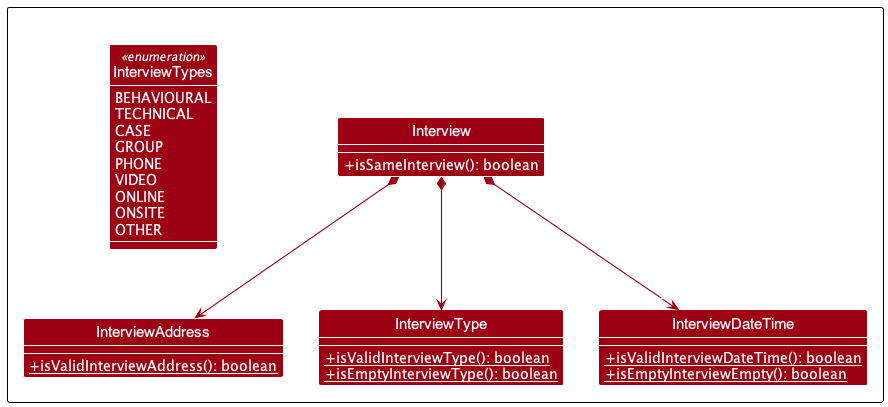
Interview Commands
The Interview commands are implemented with InterviewCommand and InterviewCommandParser.
During parsing of user input in ApplicationBookParser, if the input starts with “interview”, the remaining input
is passed as an argument to the InterviewCommandParser which parses it and invokes the respective sub-command parsers.
The abstract InterviewCommand class extends the Command class to hide the internal logic
and execution of the interview sub-commands.
The InterviewCommand::getJob method retrieves the job of an interview so that the execution of the sub commands
can be carried out on the Job that contains the Interview to be modified.
There are 3 sub-commands to access and modify an Interview:
interview add- To add an interview to aJob.interview delete- To delete an interview from aJob.interview edit- To edit an interview from aJob.
The following class diagram illustrates the structure of an InterviewCommand and the sub-commands it is associated
with:
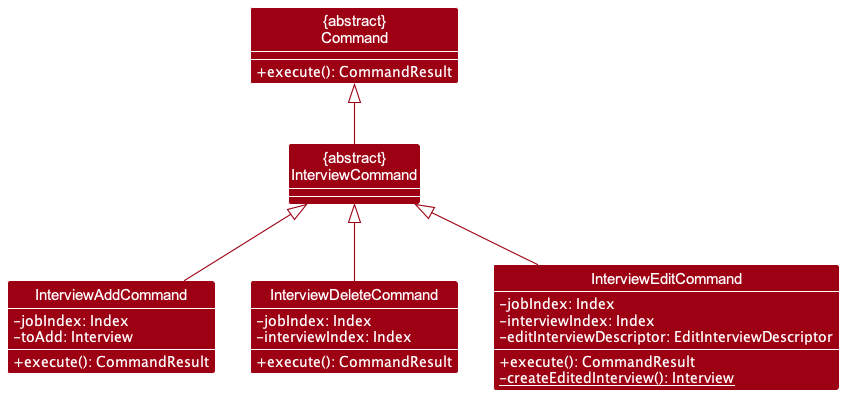
Interview Add Command
The adding of an interview to a Job is implemented with InterviewAddCommand and InterviewAddCommandParser.
The following sequence diagrams illustrate the process of parsing and execution for the interview add command:
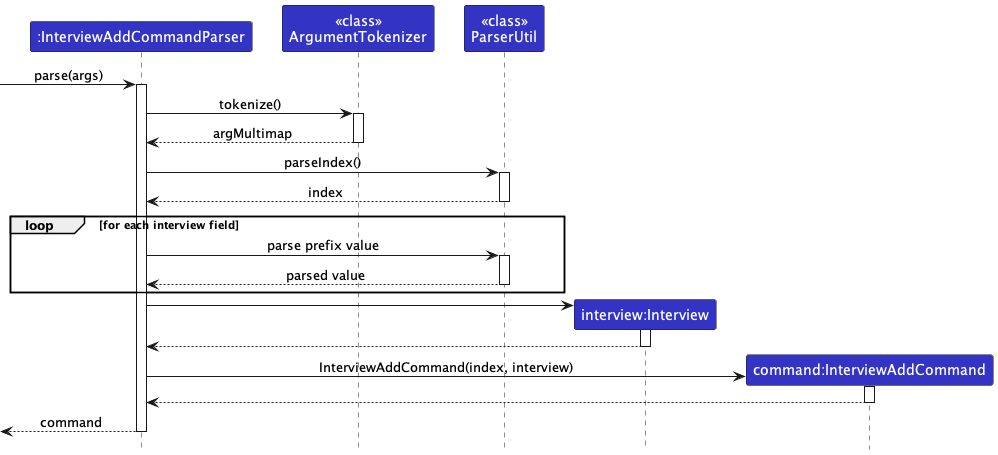
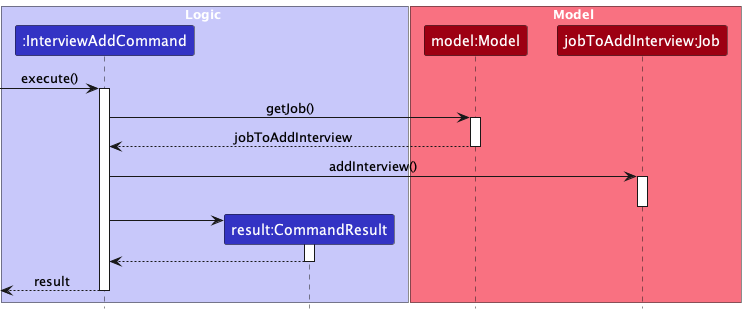
When the InterviewAddCommandParser::parse is invoked by InterviewCommandParser, the ArgumentTokenizer class parses
the arguments to determine the index of the Job, interviewType, interviewDateTime and interviewAddress.
If the user input does not conform to the expected prefixes, a ParseException is thrown. If the user input is valid,
a new Interview is created with the interviewType,interviewDateTime and interviewAddress parsed. An
InterviewAddCommand is generated with the job index and the created Interview.
During execution of InterviewAddCommand, the new Interview is passed to the Job to handle the adding of the
Interview to it’s list of interviews.
Interview Delete Command
Deleting of an interview from a specified Job is implemented with InterviewDeleteCommand and
InterviewDeleteCommandParser.
The following sequence diagrams illustrate the process of parsing and invocation for the command:
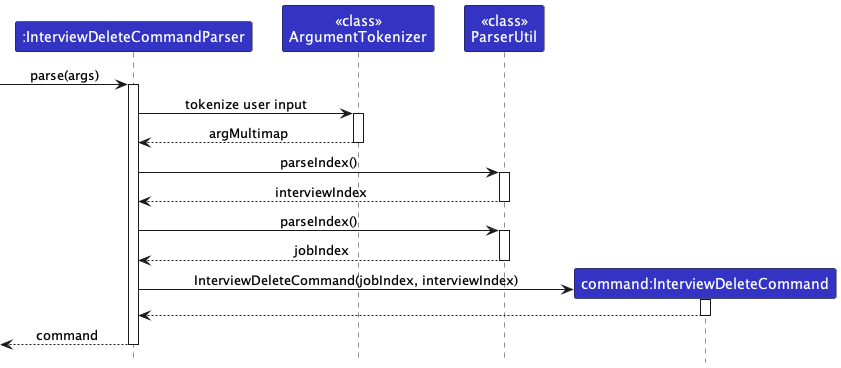
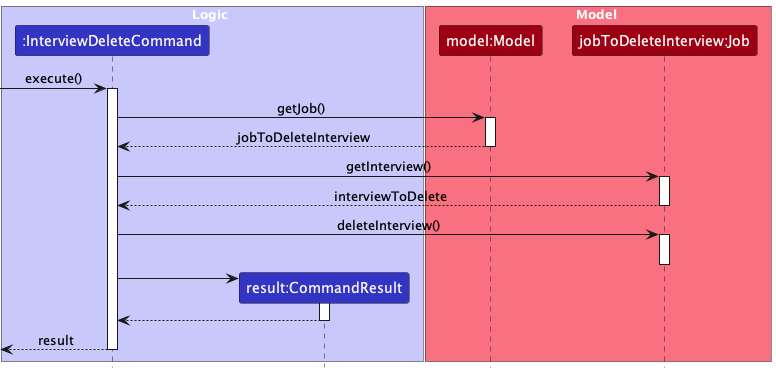
When the InterviewDeleteCommandParser::parse is invoked by InterviewCommandParser, the ArgumentTokenizer class
parses the arguments to determine the index of the Interview to be deleted and the index of the Job it
is to be deleted from.
If the user input does not conform to the expected prefixes, a ParseException is thrown. If the user input is valid,
an InterviewDeleteCommand is generated with the jobIndex and interviewindex.
During execution of InterviewDeleteCommand, the Job and Interview objects are passed to the Model to handle the
deletion of the Interview from the Job.
Interview Edit Command
Editing of an interview from a specified Job is implemented with InterviewEditCommand and
InterviewEditCommandParser.
The following sequence diagrams illustrate the process of parsing and invocation for the command:
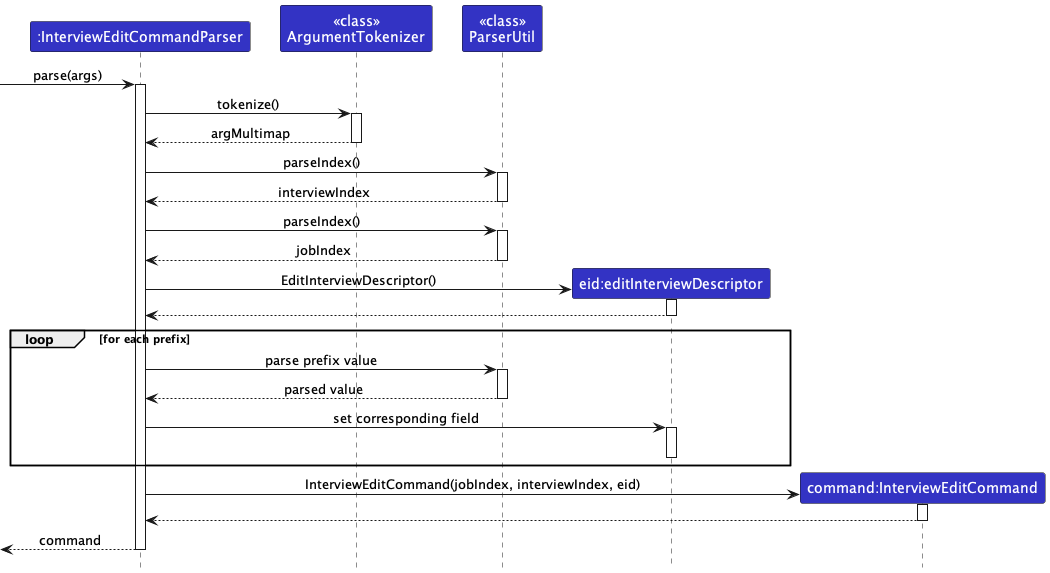
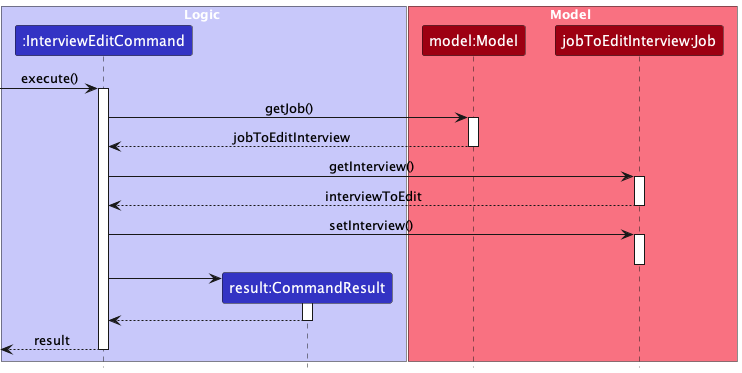
When the InterviewEditommandParser::parse is invoked by InterviewCommandParser, the ArgumentTokenizer class
parses the arguments to determine the index of the Interview to be edited, index of the Job it
is to be edited from and the fields to be edited.
If the user input does not conform to the expected prefixes, a ParseException is thrown. If the user input is valid,
an EditInterviewDescriptor is created to store the details to edit the interview with. An InterviewEditCommand is
then generated with the jobIndex, interviewindex and the editInterviewDescriptor.
During execution of InterviewEditCommand, the interviewToBeEdited and editedInterview created is passed to the
Job to handle the modification of the Interview.
Design considerations
- How to implement multiple interviews in for a Job Application
- Chosen implementation: Each
Jobstores a list of interviews asList<Interviews>. This was easier to implement, but had less abstraction. Due to the tight timeline as interviews was a feature implemented only in v1.3, we decided to choose this implementation. - Alternative: Create an
InterviewListclass to store the list of interviews and handle the changes to the interviews. EachJobwould have anInterviewListinstead. This provided a higher level of abstraction, enabling us to easily add more commands to manipulate the list of interviews in the future. However, this would take more time. Additionally, there are currently minimal commands to manage the interviews and adding an extra layer may add unnecessary complication to the codebase.
- Chosen implementation: Each
Other Relevant Documentation
Appendix A: Requirements
Product scope
Target user profile:
- NUS fresh graduates who are looking for jobs
- Has a need to manage a significant number of job applications
- Prefers desktop apps over other types
- Able to type fast
- Prefers typing to mouse interactions
- Reasonably comfortable using CLI apps
Value proposition: Manage job applications faster than a typical mouse/GUI-driven app.
User stories
Priorities: High (must have) - ***, Medium (nice to have) - **, Low (unlikely to have) - *
| Priority | As a … | I want to … | So that I can… |
|---|---|---|---|
*** |
user | add applications I have applied to, including their names and contact information | keep track and manage my job applications |
*** |
user | record application deadlines for each job listing | stay organized on application deadlines |
*** |
user | mark the status of each application | keep track of application progress |
*** |
user | delete job applications that are no longer relevant | update my list according to my current interests |
*** |
user | view all applications I have added |
Use cases
For all use cases below, the System is the JobFindr (JobFindr) and the Actor is the User, unless specified
otherwise. Furthermore, any reference to the list refers to the main list of job applications, unless specified
otherwise.
System: JobFindr
Actor: User
Application: Job Application
Use case: UC1 - Add an application
MSS
- User requests to add a job application to the list.
-
System adds the application.
Use case ends.
Extensions
- 1a. System detects an error in the input.
-
1a1. System shows an error message.
Use case resumes at step 1.
-
Use case: UC2 - Delete an application
MSS
- User requests to delete an application in the list, specifying an index.
-
System deletes the application at the index specified.
Use case ends.
Extensions
-
2a. The list is empty.
Use case ends.
-
3a. The given index is invalid.
-
3a1. System shows an error message.
Use case resumes at step 3.
-
Use case: UC3 - List applications
MSS
- User requests to list applications
-
System shows a list of applications
Use case ends.
Use case: UC4 - Find an application
MSS
- User lists application UC3.
- User requests to find a list of applications based on the given keywords.
-
System shows a list of applications with any of the fields (
Company,Role,Status,Deadline,JobType,Industry) containing the given keywords.Use case ends.
Extensions
-
2a. No applications match the given keywords.
Use case ends.
Use case: UC5 - Find an application by specific field(s)
MSS
- User lists application UC3.
- User requests to find a list of applications based on the given keywords for specific field(s).
-
System shows a list of applications with the given field(s) containing the given keywords for each field.
Use case ends.
Extensions
-
2a. No applications match the given keywords.
Use case ends.
Use case: UC6 - Edit an application
MSS
- User finds application UC4.
- User requests to edit an application in the list, specifying an index.
-
System updates the relevant fields in the application at the index specified.
Use case ends.
Extensions
-
2a. The list is empty.
Use case ends.
-
3a. The given index is invalid.
-
3a1. System shows an error message.
Use case resumes at step 2.
-
Use case: UC7 - Sort applications
MSS
- User requests to sort the list of applications by a specific field.
-
System sorts the list of applications by the given field.
Use case ends.
Extensions
-
1a. The list is empty.
Use case ends.
-
2a. The given field is invalid.
-
2a1. System shows an error message.
Use case resumes at step 1.
-
Use case: UC8 - Select an application
MSS
- User requests to select an application in the list by clicking on it.
-
System displays details of the selected application.
Use case ends.
Use case: UC9 - Add interview
MSS
- User finds application UC4.
- User requests to add an interview to the application, specifying an index.
- System creates an Interview object.
-
System adds the interview to the application at the index specified.
Use case ends.
Extensions
- 1a. The application does not exist.
-
1a1. System shows an error message.
Use case resumes at step 2.
-
- 2a. The given index is invalid.
-
2a1. System shows an error message.
Use case resumes at step 2.
-
- 2b. The interview already exists.
-
2b1. System shows an error message.
Use case resumes at step 2.
-
- 2c. The interview has invalid fields.
-
2c1. System shows an error message.
Use case resumes at step 2.
-
Use case: UC10 - Delete interview
MSS
- User requests to delete an interview from the application, specifying the interview index and the application index.
-
System deletes the interview from the application at the index specified.
Use case ends.
Extensions
- 1a. The application does not exist.
-
1a1. System shows an error message.
Use case resumes at step 2.
-
- 1b. The interview to be deleted does not exist.
-
1b1. System shows an error message.
Use case resumes at step 2.
-
Use case: UC11 - Edit interview
MSS
- User requests to edit an interview from the application, specifying the interview index and the application index.
-
System updates the relevant fields in the interview at the index specified.
Use case ends.
Extensions
- 1a. The application does not exist.
-
1a1. System shows an error message.
Use case resumes at step 2.
-
- 1b. The interview to be edited does not exist.
-
1b1. System shows an error message.
Use case resumes at step 2.
-
- 1c. The interview to be created has invalid fields.
-
1c1. System shows an error message.
Use case resumes at step 2.
-
Use case: UC12 - Clear all applications
MSS
- User requests to clear all applications.
-
System clears all applications.
Use case ends.
Use case: UC13 - Exit application
MSS
- User requests to exit the application.
-
System exits the application.
Use case ends.
Use case: UC14 - Open help window
MSS
- User requests to open the help window.
-
System opens the help window.
Use case ends.
Non-Functional Requirements
Availability
- The application is available for download on our GitHub release page in the form of a JAR file.
Capacity
- The application should be able to store up to 1000 job applications.
Performance
- Response time to any user command is within 3 seconds.
- The application should be able to contain and handle up to 300 job applications before facing any form of performance bottleneck issues.
Reliability
- The application should guide the user if it is unable to execute any of the user actions for various reasons.
Compatibility
- The application should work as intended on any mainstream operating systems.
- The application is guaranteed to work on Java version 11.
Usability
- A user with above average typing speed for regular English text (i.e. not code, not system admin commands) should be able to accomplish most of the tasks faster using commands than using the mouse.
Robustness
- The application should remain highly relevant to job applications at any point in the future.
Integrity
- There should be user updates to the job applications to ensure its integrity.
- When there is an application update, it should not compromise the integrity of the save file.
Maintainability
- The application should be compliant with the coding standard and best coding practices highlighted in CS2103T.
- The application should be designed such that any programmer with at least a year of experience should be able to read, maintain, and contribute to the source code easily.
Process
- The project features are to be in line with any changes to real world job application process.
Project Scope
- The application requires manual addition of job applications into the system.
Privacy
- The application should not store any information related to the user’s job applications in remote storage.
Glossary
- Mainstream OS: Windows, Linux, Unix, OS-X
- CLI: Command Line Interface. A user interface that allows users to interact with the software using text commands via a console or terminal.
- GUI: Graphical User Interface. A user interface that allows users to interact with the software through graphical icons and visual indicators, as opposed to text-based interfaces.
- UI: User Interface
- MSS: Main Success Scenario
- Job Application: A record of a job application that contains relevant information.
- Fields: The attributes of a job application, namely company, role, status, deadline, job type, industry, and interview details.
Appendix B: Instructions for Manual Testing
Given below are instructions to test the app manually.
Note: These instructions only provide a starting point for testers to work on; testers are expected to do more exploratory testing.
B.1. Launch and Shutdown
- Initial launch
- Download the jar file and copy into an empty folder
-
Double-click the jar file
Expected: Shows the GUI with a set of sample contacts. The window size may not be optimum.
- Saving window preferences
- Resize the window to an optimum size. Move the window to a different location. Close the window.
-
Re-launch the app by double-clicking the jar file.
Expected: The most recent window size and location is retained.
B.2. View Sample Job Application List
- Close JobFindr.
- Delete the file
./ApplicationBook.jsonin the data folder (if applicable). -
Launch JobFindr.
Expected: A sample job application list with 7 job applications is loaded.
B.3. View Job Application List
- Viewing the list of job application(s).
-
Test case:
listExpected: The list of job applications is shown in the GUI.
-
B.4. Add Job Application
- Adding a job application.
-
Test case:
add c/Microsoft r/Project Manager d/Dec 31 2023 1400 i/Technology s/Pending t/FULL_TIMEExpected: New job application is added to the bottom of the list. Details of the newly-added application is shown in the feedback box.
-
Test case:
add r/Data AnalystExpected: Job application is not added. Error details are shown in feedback box.
-
B.5. Delete Job Application
- Deleting a job application by index.
- Prerequisites: At least one job application is displayed.
-
Test case:
delete 1Expected: The first job application is deleted from the list. Details of the deleted application is shown in the feedback box.
-
Test case:
delete 0Expected: No job application is deleted. Error details are shown in feedback box.
-
Other test cases:
delete,delete x(where x is larger than the list size)Expected: Similar to test case 2.
-
- Prerequisites: At least one job application is displayed.
B.6. Edit Job Application
- Editing a job application by index.
- Prerequisites: At least one job application is displayed.
-
Test case:
edit 1 c/Google r/Software EngineerExpected: The first job application is edited. Details of the edited application is shown in the feedback box.
-
Test case:
edit 0 c/Google r/Software EngineerExpected: No job application is edited. Error details are shown in feedback box.
-
Test case:
edit c/Google r/Software EngineerExpected: Similar to test case 2.
-
Test case:
edit 1 d/Nov 31 2023 1400Expected: Invalid date format. Error details are shown in feedback box.
-
Test case:
edit 1 s/Expected: Invalid status format. Error details are shown in feedback box.
-
Test case:
edit 1 q/Expected: Invalid prefix. Error details are shown in feedback box.’
-
- Prerequisites: At least one job application is displayed.
B.7. Add Interview to Job Application
- Adding an interview to a job application by index.
- Prerequisites: List all job applications using
list.-
Test case:
interview add 1 t/Technical a/Changi Business Park Central 1, 486036 d/Nov 30 2023 1400Expected: Interview is added to the job application. Details of the interview is shown in the job details panel.
-
Test case:
interview add 0 t/Technical a/Changi Business Park Central 1, 486036 d/Nov 30 2023 1400Expected: No interview is added. Error details are shown in feedback box.
-
Test case:
interview add 1 t/Technical d/Nov 30 2023 1400Expected: No interview is added. All fields are compulsory. Error details are shown in feedback box.
-
- Prerequisites: List all job applications using
B.8. Delete Interview from Job Application
- Deleting an interview from a job application by index.
- Prerequisites: List all job applications using
list.-
Test case:
interview delete 1 from/1Expected: Interview is deleted from the job application. Details of the interview is removed from the job details panel.
-
Test case:
interview delete 0 from/1Expected: No interview is deleted. Error details are shown in feedback box.
-
Test case:
interview delete 1 from/0Expected: Similar error to test case 2.
-
- Prerequisites: List all job applications using
B.9. Edit Interview from Job Application
- Editing an interview from a job application by index.
- Prerequisites: List all job applications using
list.-
Test case:
interview edit 1 from/1 t/Technical a/Changi Business Park Central 1, 486036 d/Nov 30 2023 1200Expected: Interview is edited. Details of the interview is updated in the job details panel.
-
Test case:
interview edit 0 from/1 t/Technical a/Changi Business Park Central 1, 486036 d/Nov 30 2023 1400Expected: No interview is edited. Error details are shown in feedback box.
-
Test case:
interview edit 1 from/0 t/Technical a/Changi Business Park Central 1, 486036 d/Nov 30 2023 1400Expected: Similar error to test case 2.
-
Test case:
interview edit 1 from/1 t/Technical d/Nov 30 2023 1400Expected: Interview is edited. Details of the interview is updated in the job details panel.
-
Test case:
interview edit 1 from/1 t/HomeExpected: No interview is edited. Invalid interview type. Error details are shown in feedback box.
-
- Prerequisites: List all job applications using
B.10. Sort Job Application List
- Sorting the list of job application(s).
- Prerequisites: At least one job application is displayed.
-
Test case:
sort c/Expected: The list of job applications is sorted by company name.
-
Test case:
sort r/Expected: The list of job applications is sorted by role.
-
Test case:
sort s/Expected: The list of job applications is sorted by status.
-
Test case:
sort d/Expected: The list of job applications is sorted by deadline.
-
Test case:
sort t/Expected: The list of job applications is sorted by job type.
-
Test case:
sort i/Expected: The list of job applications is sorted by industry.
-
Test case:
sort x/Expected: No sorting is done. Error details are shown in feedback box.
-
- Prerequisites: Use
findcommand to reduce size of job application list without deleting any job applications. For example,find r/program.-
Test case:
sort c/Expected: No change to the number of job applications displayed.
-
- Prerequisites: Ensure current job applications list has multiple applications with fields of the same value. For
example, multiple applications with the
roleofsoftware developer.-
Test case:
sort r/Expected: No change in order of job applications with identical roles.
-
- Prerequisites: At least one job application is displayed.
B.11. Find Job Application
- Finding a job application by keywords.
- Prerequisites: Starting with the sample job application list. Refer to B.2. for steps to load the sample job
application list.
-
Test case:
findExpected: No change in list. Error details shown in the feedback box as at least one of the optional parameters must be entered.
-
Test case:
find full_timeExpected: Applications with the keyword
full_timein any field are shown in the list. -
Test case:
find s/PendingExpected: All applications with
PENDINGstatus are shown in the list. -
Test case:
find DecExpected: All applications with
Decin the deadline are shown in the list. -
Test case:
find ShopExpected: No application is listed.
finddoes not work with partial keywords.
-
- Prerequisites: Starting with the sample job application list. Refer to B.2. for steps to load the sample job
application list.
B.12. Clear Job Application List
- Clearing the list of job application(s).
- Prerequisites: At least one job application is displayed.
-
Test case:
clearExpected: The list of job applications is cleared. The list is empty.
-
- Prerequisites: At least one job application is displayed.
B.13. Exit JobFindr
- Exiting the application.
-
Test case:
exitExpected: The application window closes.
-
B.14. Help
- Opening the help window.
-
Test case:
helpExpected: The help window opens.
-
Appendix C: Effort
Working with JavaFX
JavaFX is a GUI library that was briefly taught as part of our individual project. While the tutorial was helpful in giving us a basic understanding of JavaFX, we still had to spend a significant amount of time learning how to use JavaFX to implement the GUI for JobFindr. This was especially challenging as we had to learn how to use JavaFX while implementing the GUI for JobFindr at the same time. Challenges include:
- Learning how to use SceneBuilder: SceneBuilder was introduced as a useful framework to expedite the process of using JavaFX to implement the GUI. However, SceneBuilder proved to be difficult to use as it was not intuitive and lacks the flexibility needed to implement certain features that we wanted to include. For example, we wanted to include a
JobDetailsPanelto display the fields and interviews of a job application. However, SceneBuilder lacked the necessary tools to allow us to customize theJobDetailsPanelto our liking. We ended up having to implement theJobDetailsPanelmanually using JavaFX. - Learning how to use CSS: We wanted to use CSS to customize the look and feel of the GUI. However, we had no prior experience with CSS and had to spend a significant amount of time learning how to use CSS to customize the GUI. We also had to learn how to use CSS with JavaFX as there were some differences between using CSS with JavaFX and using CSS with HTML.
- Overall Steep Learning Curve: There are many intricacies within JavaFX that were not extensively covered in the tutorials provided. We had to do a lot of research to figure out how to implement JavaFX features. For example, we had to modify the
CommandResultclass to support updating theJobDetailsPanelwhenever an interview is added, edited or deleted.
Appendix D: Planned Enhancements
The current implementation of JobFindr allows users to manage their job applications relatively efficiently through a CLI. However, we have identified several areas for improvement in terms of flexibility, efficiency and organization. As such, our proposed enhancements are targeted at improving these areas.
D.1. Warning for Clear Command
Current State
The clear command executes without any prior warning, risking accidental deletion of all job applications without warning.
Planned Enhancement
We plan to introduce a confirmation step before the execution of the clear command.
Implementation Details
- Confirmation Prompt: Introduce an interactive prompt requiring explicit user confirmation before executing the
clearcommand. - Command-Line Argument: Optionally, provide a command-line argument to bypass the confirmation for automated scripts.
D.2. Enhanced Sort Feature
Current State
The sort command places all the empty optional fields at the end of the job application field after sorting based on an optional field. For example, if the user sorts the job application list by status, all the job applications with no status (i.e. TO_ADD_STATUS) will be placed at the end of the list. This is not ideal as the user may want to view all the job applications with no status at the top of the list.
Planned Enhancement
We plan to make sort show all the job applications with empty optional fields at the top of the list after sorting based on an optional field.
Implementation Details
- Sorting Algorithm: Modify the sorting algorithm to place all the job applications with empty optional fields at the top of the list after sorting based on an optional field.
- Updated User Interface: Update the user interface to show all the job applications with empty optional fields at the top of the list after sorting based on an optional field.
- Performance Considerations: The sorting algorithm should be efficient enough to handle a large number of job applications.
D.3. Arrange Interviews in Chronological Order
Current State
The interview command arranges interviews based on the order they are added. This may lead to confusion as the user is unable to view the interviews in chronological order.
Planned Enhancement
We plan to arrange interviews in chronological order for each job application.
Implementation Details
- Add Field Comparator: Add a field comparator to sort the interviews in chronological order, much like how
deadlineis sorted.
D.4. Allow Interviews to have Multiple Types
Current State
The interview command only allows users to add one type of interview to each job application. For example, an interview can be labelled as Technical or Online, but not both. This is not flexible enough as it is common for interviews to have multiple types associated with them.
Planned Enhancement
We plan to allow users to add multiple types to each interview. An interview can have as many types as the user wants as long as they are valid.
Implementation Details
- Modify Interview Type Field: Modify the interview type field to be a
Setinstead of aString. This allows users to add multiple types to each interview. - Update User Interface: Update the user interface to support displaying the multiple interview types as a
String.
D.5. Enhanced User Customization
Current State
Theadd command only allows users to add fields that are already defined in the Job class. This is not flexible enough as users may want to add their own fields to the job application. Moreover, users are unable to choose which fields are shown in the job application list.
Planned Enhancement
We plan to allow users to add their own fields to the job application and choose which fields are shown in the job application list.
Implementation Details
- Add Custom Fields: Allow users to add their own fields to the job application.
- Choose Fields to Show: Add a toggle that allows users to choose which fields are shown in the job application list.
D.6. Improve Keyboard Functionality
Current State
The JobFindr application currently does not support keyboard shortcuts. This is not ideal as experienced users may want to execute commands using keyboard shortcuts for faster execution.
Planned Enhancement
We plan to allow users to use keyboard shortcuts to execute commands for faster execution.
Implementation Details
- Add Keyboard Shortcuts: Add specific listeners to the
JobFindrapplication to listen for keyboard shortcuts. When a keyboard shortcut is detected, the corresponding command is executed. - Update User Interface: Update the user interface to support keyboard shortcuts.
D.7. Implement an Integrated Dashboard
Current State
The JobFindr application currently only displays a list of job applications. This is not ideal as users may want to view their job applications in a more organized manner. For example, users may want to view their job applications categorized by a specified field.
Planned Enhancement
We plan to implement an integrated dashboard that allows users to view their job applications in a more organized manner.
Implementation Details
- Update User Interface: Update the user interface to support the integrated dashboard. This involves adding panels to display multiple lists of job applications categorized by a specified field.
- Modify
Sortcommand: Modify thesortcommand to support sorting by multiple fields. This allows users to sort the job applications in the integrated dashboard by multiple fields.